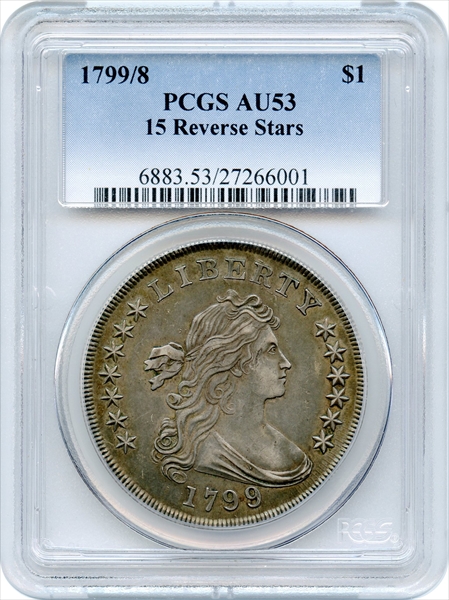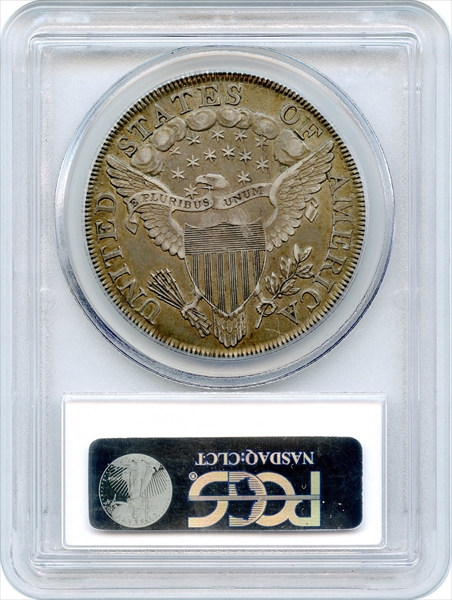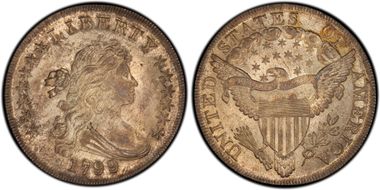1799/8 $1 BB-141 AU53 认证号27266001, PCGS号40064
拥有者评论
B-3, BB-141
专家评论
Q. David Bowers
The following narrative, with minor editing, is from my "Silver Dollars & Trade Dollars of the United States: A Complete Encyclopedia" (Wolfeboro, NH: Bowers and Merena Galleries, Inc., 1993). Note: the Notable Specimens list should be used with caution - it has been updated in my 2013 edition of "The Encyclopedia of United States Silver Dollars 1794-1804."Bolender 3, Haseltine 3
OBVERSE 1: 1799, last 9 punched over previous 8, and definitive as such; the only overdate die of the year. Last 9 of date very close to bust. Stars very close together. Letters of LIBERTI are widely spaced. Die flaws at left base of E, under RT, and above R. The same obverse die was shared to coin BB-141, BB-142, and BB-143. This die was not used to strike 1798 dollars before it was overdated.
Obverse die used to strike BB-141 (lst use), BB-142 (2nd use), and BB-143 (relapped; 3rd use).
REVERSE A: 15 stars on reverse; this is definitive, although to the uninitiated the two extra stars are not readily seen, at least at first. The two supernumerary stars are nearly lost in cloud 1 and cloud 8, and just the points show. The one protruding from the bottom of cloud 1 is the most easily seen; The result is a blundered arc pattern of stars with five (instead of six) stars in the top row, six (instead of five) in the, second row, and the usual one to each side of the eagle's, head, plus the superfluous star points peeking out from the bottoms of clouds 1 and 8.
The process was accomplished as follows: The engraver first punched seven stars in the top row, six in the second row, and the normal single stars to each side of the eagle's head. He then took count and realized that he had one too many stars in the top row, and one too many stars in the second row, for a total of 15. To disguise his blunder, he enlarged clouds 1 and 8, making them greatly oversized to cover up the first and last stars in, the top row, reducing the count-to an abnormal five (instead of the normal six), so that the abnormal six (instead of five) in the second row would not have to be altered. The normal star arrangement, top to bottom, is: 6-5-2. Before alteration, this reverse die was 7-6-2. After alteration, it was 5-6-2.
Leaf point under left upright of I in America. Die crack near border above ATES. Another crack above OF AM. The D in UNITED is repunched and there are die flaws in the right side of this letter. Far right edge of A is over cloud 3. Reverse usually not fully struck up at the center, due to sinking of the die.
Note: Die state progressions reveal that the 1799/ 8 overdates, which are die linked to regular 1799 dollars, were struck after certain regular or perfect date (non-overdate) pieces were made. The overdates are listed first here, following numismatic tradition.
Reverse die used to strike 1799 BB-141 (later use with 1799/8 overdate obverse) and 1799 BB-153 (earlier use with non-overdated obverse).
STATES:
Die State I: Perfect dies. Reverse without cracks. May not exist.
Die State II: Early state of obverse later used to coin BB- 142 and BB-143. Tiny flaw or crack above R in LIBERTY does not extend to left beyond R. Minute raised flaw at left base of E. Several raised flaws below RT. Three or four small raised areas starting to develop behind hair and above ribbon. Very tiny flaw between ray of star 7 and the bottom left of L. Reverse die with cracks as described above under BB-141.
Die State III: Obverse as preceding. Reverse with additional crack from right ribbon through AMERIC.
Die State IV: As preceding, but on reverse, a tiny additional crack develops below left upright of M to wing.
COLLECTING NOTES: In terms of availability among overdates of this year, 1799/8 BB-141 is the most plentiful, edging out BB-142 by a healthy margin. It seems likely that about 700 to 1,200 are known today of this variety. This is nice, as it makes the interesting combination of the overdate obverse and the blundered die reverse available to all.
Examples exist in all grades through Mint State, and in terms of early dollars, is actually plentiful in the latter grade! Perhaps someone found a cache of a few dozen of them many years ago. Whatever the reason might be, it has not been recorded.
NOTABLE SPECIMENS:
Rarcoa Specimen. MS-64. Rarcoa, Auction '83, 1983:1162. "Superb gem brilliant Unc. Blazing, frosty surfaces and totally full, complete strike makes this specimen truly incredible." . Rarcoa, Auction '85, 1985:264. "Superb gem brilliant Une. Blazing, frosty surfaces and totally full, complete strike makes this specimen truly incredible." Rarcoa, Auction '86, 1986:731. "Superb gem brilliant Unc. Blazing, frosty surfaces and totally full, complete strike makes this specimen truly incredible."
Austin Specimen. MS-63. Bowers and Ruddy Galleries, Austin Collection, 1974:25. "Choice Brilliant Unc. Some microscopic marks are visible with a glass."
Stack's Auction '83 Specimen. MS-63. Stack's, 1983: 721. "Unc. and choice. Full frosty lustre with exquisite gray, russet, and seagreen toning."
June Sale Specimen. MS-63. Stack's, June Sale, 1990:400. "Choice Brilliant Unc. 'Chalk-white, frosty lustre indicative of a completely natural, untouched coin. Delicate amber russet toning."
Boyd Specimen. MS-60. Numismatic Gallery, World's Greatest Collection, F.C.C. Boyd, 1945: 63. "A superb Unc. coin. Also the 1799 over 98 variety."
Davis Specimen. MS-60. Stack's, Davis-Graves Games Davis) Collection, 1954:1296. "Unc., with almost full mint bloom."
Anderson-Dupont Specimen. MS-60. Stack's, Anderson-Dupont Collection, 1954:2502. "Unc., full mint lustre."
Baldenhofer Specimen. MS-60. W. G. Baldenhofer to Stack's, Farish-Baldenhofer Sale, 1955 AJ. Ostheimer, 3rd Collection• Superior Galleries, Gilhousen Collection, 1973:1248. "Very deeply toned Unc., faintest suggestion of cabinet friction in one or two tiny places on reverse." • Superior Galleries, ANA Convention Sale, 1975: 912. "Very deeply toned Unc., faintest suggestion of cabinet friction in one or two tiny places on reverse."
New Netherlands Specimen. MS-60. New Netherlands 51st Sale, 1958:696. "Far advanced and unlisted die injuries. Brilliant Unc., with some golden tone and some light tarnish."
Wolfson Specimen. MS-60. Stack's, Samuel W. Wolfson Collection, 1963:1381. "Lustrous, lightly toned, nicely struck. Unc., fairly well centered."
Hollinbeck-Kagin Specimen. MS-60. Hollinbeck-Kagin Sale, January 1970:785. "Unc, with glittering bluish golden patina, sharp denticles obverse and reverse." HollinbeckKagin Sale, June 1970:619. "Unc. with lovely prooflike patina, struck from slightly swelled reverse die resulting in some of the eagle's wing feathers not being fully struck up." • Hollinbeck-Kagin Sale, August 1970:1084. "Unc. golden, sharp struck."
Davenport Specimen. MS-60. Eastern collection. Superior Galleries, ANA Convention Sale, 1975:911. "MS-60 or so, frosty with a touch of golden about the devices, and lustrous. Excellent surfaces with minimal handling marks. Not fully struck up in the center portions of the reverse as usual for this variety. Pedigree: From a famous eastern collection." Superior Galleries, Davenport Collection, 1977:476. "MS-60 or so, frosty with a touch of golden about the devices, and lustrous. Excellent surfaces with minimal handling marks. Not fully struck up in center portions of the reverse." Superior Galleries, February 1981:650. "MS-60. Frosty, with a touch of golden about the devices, and lustrous. Excellent surfaces with minimal handling marks. Not fully struck up in center portions of the reverse."
Robison Specimen. MS-60. Stack's, Ellis H. Robison Collection, 1982:1869. "Brilliant Unc. Lovely pale russet gray with faint iridescent overtones."
Heifetz Specimen. MS-60. Superior Galleries, Jascha Heifetz Collection, 1989:2393. "MS-60. Lovely silvery gray toning on the obverse and reverse with touches of lilac in the fields. Sharply struck, especially about the periphery with all of the obverse stars boldly struck up. The reverse is also well struck with each star visible above the eagle's head in the field. Late die state with some weakness in the central curls of Liberty and heavily clashed on the obverse and reverse. Additionally, the milling is clashed below the bust."
PCGS #
40064
设计师
Robert Scot
边缘
Lettered: HUNDRED CENTS ONE DOLLAR OR UNIT
直径
40.00 毫米
重量
27.00 克
铸币数量
423515
金属成分
90% Silver, 10% Copper
更高评级数量
10
评级较低的钱币数量
19
地区
The United States of America
价格指南
PCGS 数量报告
拍卖 - PCGS 评级的
拍卖 - NGC 评级的



























